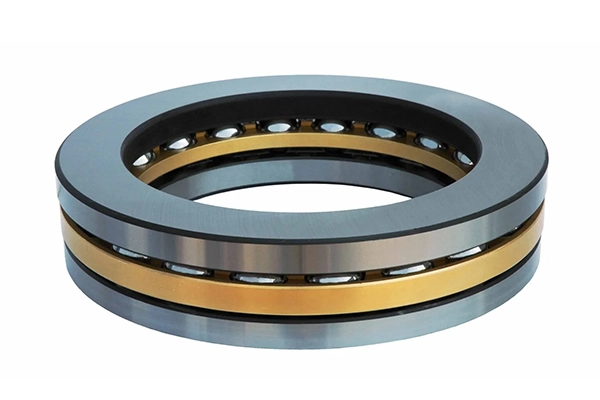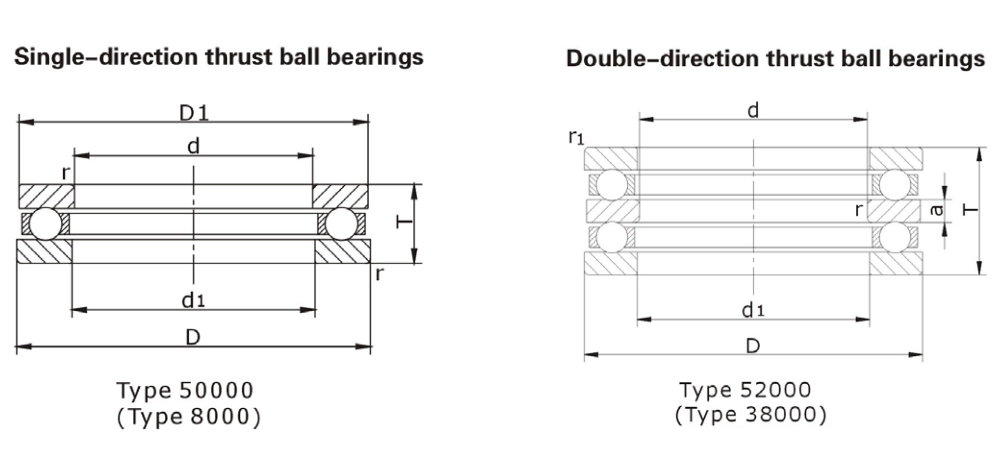What Materials Are Large Thrust Ball Bearings Made Of?
Large thrust ball bearings are critical components in numerous industrial applications where they manage significant axial loads while allowing rotational movement. These specialized bearings are designed to handle thrust loads in one direction and are crucial in heavy machinery, power generation equipment, and various industrial applications. The materials used in manufacturing large thrust ball bearings significantly influence their performance, durability, and suitability for specific operating conditions. This article explores the various materials employed in the production of large thrust ball bearings and their respective properties and applications.

What Makes Large Thrust Ball Bearings Different From Other Bearing Types?
Structural Distinctions of Large Thrust Ball Bearings
Large thrust ball bearings possess a unique design compared to other bearing types, featuring flat races and ball elements arranged in a single plane. This distinctive structure allows them to support substantial axial loads while permitting rotational movement. Unlike radial bearings that primarily handle forces perpendicular to the shaft, large thrust ball bearings are engineered specifically to manage forces parallel to the shaft axis. The dimensional specifications of large thrust ball bearings are significantly greater than standard bearings, with diameters often exceeding 100mm and sometimes reaching several meters for specialized industrial applications. These bearings typically include a shaft washer, a housing washer, and ball elements contained within cages that maintain proper spacing.

Load-Bearing Capabilities and Applications
The exceptional load-bearing capabilities of large thrust ball bearings make them indispensable in heavy industrial settings. These bearings can support tremendous axial loads, sometimes exceeding several hundred tons in specialized applications like hydroelectric turbines or heavy industrial gearboxes. Large thrust ball bearings function optimally in applications with moderate speeds and predominantly axial loads. They are commonly installed in vertical shaft arrangements where gravity contributes significantly to the thrust forces. Key applications include marine propulsion systems, where they support the tremendous forces generated by large propellers; hydroelectric generators, where they bear the combined weight of the turbine and water pressure; construction equipment like excavators and cranes, where they manage directional forces; and industrial gearboxes, where they handle thrust loads generated by helical or bevel gears.
Operating Conditions and Performance Requirements
Large thrust ball bearings operate under demanding conditions that necessitate exceptional material properties. These bearings frequently encounter extreme temperature variations, ranging from sub-zero conditions in outdoor equipment to several hundred degrees Celsius in industrial furnaces or processing equipment. Exposure to corrosive environments, such as chemical processing plants, offshore installations, or food processing facilities, places additional demands on material selection for large thrust ball bearings. High-speed applications generate significant heat through friction, requiring materials with excellent thermal stability and heat dissipation properties. Industrial settings often expose large thrust ball bearings to contamination from dust, debris, and process materials, necessitating materials that resist abrasion and wear. The intermittent or shock loading typical in equipment like presses or stamping machines demands materials with high fatigue resistance and toughness.
How Do Materials Affect the Performance of Large Thrust Ball Bearings?
Impact of Material Selection on Bearing Lifespan
The material composition of large thrust ball bearings profoundly influences their operational lifespan. High-carbon chromium steels like AISI 52100 have become industry standards due to their exceptional fatigue resistance and ability to maintain dimensional stability under cyclic loading. These materials can extend the service life of large thrust ball bearings by factors of three to five compared to lower-grade alternatives. The hardness profile throughout the bearing components directly correlates with wear resistance, with properly heat-treated bearings exhibiting 20-30% longer lifespans than those with inconsistent hardness distributions. Material homogeneity plays a crucial role in preventing premature failure, as inclusions or impurities often serve as initiation points for cracks and subsequent failure. Advanced materials like carburized stainless steels combine excellent corrosion resistance with enhanced surface hardness, extending bearing life by up to 40% in challenging environments. Modern material science has introduced nanostructured steels with refined grain boundaries that demonstrate up to 25% improvement in rolling contact fatigue resistance compared to conventional materials.
Correlation Between Material Properties and Load Capacity
Material properties directly dictate the load-carrying capacity of large thrust ball bearings. The compressive strength of bearing materials establishes the foundation for load capacity, with high-chromium steels typically offering compressive strengths exceeding 2000 MPa. This impressive strength enables large thrust ball bearings to support static loads of several hundred tons in extreme applications. The elastic modulus of bearing materials impacts deflection under load, with stiffer materials minimizing deformation and maintaining proper running geometry even under extreme pressures. Surface hardness, typically measured in Rockwell C scale (HRC), correlates directly with the bearing's ability to resist surface deformation under point contact stresses. Premium large thrust ball bearings achieve surface hardness values of 58-64 HRC through specialized heat treatment processes. The balance between hardness and toughness is particularly critical for large thrust ball bearings that experience shock loading or vibration. Materials with optimized microstructures can provide both high hardness and sufficient toughness to prevent brittle failure. Thermal stability becomes increasingly important as the physical dimensions of large thrust ball bearings increase, since thermal expansion can significantly alter operating clearances and contact patterns.
Role of Materials in Friction Reduction and Energy Efficiency
Material selection significantly impacts the frictional characteristics and energy efficiency of large thrust ball bearings. Surface finish quality, determined by material machining properties and hardness, directly affects the coefficient of friction. Highly polished races made from premium bearing steels can achieve remarkably low friction coefficients of 0.001-0.003 under proper lubrication conditions. Advanced materials with optimized microstructures contribute to reduced energy consumption, with studies demonstrating energy savings of 5-15% when comparing conventional steel bearings to those made with specialized materials and surface treatments. The thermal conductivity of bearing materials influences heat dissipation during operation, with high thermal conductivity materials preventing localized overheating that could otherwise lead to lubrication breakdown and increased friction. Ceramic materials used in hybrid large thrust ball bearings offer inherently lower coefficients of friction than steel-on-steel contact, reducing frictional losses by up to 40% in some applications. Surface treatments and coatings applied to conventional bearing materials can significantly alter tribological properties, with technologies like diamond-like carbon (DLC) coatings reducing friction by up to 30% compared to untreated surfaces.
Which Advanced Materials Are Revolutionizing Large Thrust Ball Bearing Technology?
Ceramic and Hybrid Bearing Innovations
Silicon nitride (Si₃N₄) ceramics have emerged as revolutionary materials for large thrust ball bearings, offering density approximately 40% lower than steel while maintaining comparable or superior hardness. This remarkable weight reduction significantly decreases centrifugal forces in high-speed applications, allowing large thrust ball bearings to operate at speeds up to 30% higher than all-steel designs. Hybrid large thrust ball bearings, combining ceramic balls with steel races, leverage the benefits of both materials—the wear resistance and electrical insulation of ceramics with the toughness and cost-effectiveness of steel. In temperature-sensitive applications, silicon nitride's thermal expansion coefficient (approximately one-third that of steel) helps maintain more consistent operating clearances across wider temperature ranges. The inherent electrical insulation properties of ceramic materials prevent electrical current damage, a common failure mode in large motors and generators where stray currents can pit steel bearing surfaces. The smoother surface finish achievable with ceramic components reduces micropitting and associated wear by up to 80% compared to conventional steel bearings. Zirconia (ZrO₂) ceramics offer an alternative to silicon nitride in certain large thrust ball bearing applications, providing excellent fracture toughness combined with good hardness, though typically at lower maximum operating temperatures.
Development of Advanced Steel Alloys
Carburizing steel grades like AISI 8620 and 9310 have been refined specifically for large thrust ball bearings, offering exceptional core toughness combined with surface hardness exceeding 60 HRC after case hardening treatments. These materials provide superior resistance to subsurface fatigue compared to through-hardened steels. Powder metallurgy has revolutionized bearing steel production, enabling the creation of alloys with highly controlled compositions and virtually no inclusions or segregation. These premium materials demonstrate up to 300% improvement in fatigue life compared to conventionally melted steels used in large thrust ball bearings. Nitrogen-enhanced stainless steels represent a significant advancement, incorporating nitrogen atoms into the crystal structure to increase hardness without compromising corrosion resistance. These materials are particularly valuable for large thrust ball bearings in marine, food processing, or chemical industries. High-temperature bearing steels containing additions of molybdenum, tungsten, and cobalt maintain their mechanical properties at operating temperatures up to 400°C, extending the application range of large thrust ball bearings in industrial furnaces, turbines, and process equipment. Bainitic steels with specialized heat treatments offer an optimal balance of hardness and toughness for large thrust ball bearings subjected to impact or vibration loading.
Emerging Surface Treatment and Coating Technologies
Diamond-like carbon (DLC) coatings represent a revolutionary surface treatment for large thrust ball bearings, creating an incredibly hard (up to 80 HRC equivalent), low-friction surface layer that dramatically reduces wear in boundary lubrication conditions. These coatings maintain effectiveness even in starved lubrication scenarios, extending bearing life by factors of 3-5 in challenging environments. Physical vapor deposition (PVD) of titanium nitride (TiN) or chromium nitride (CrN) creates exceptionally hard surfaces (2300-2500 HV) with excellent adhesion to the base material, enhancing the performance of large thrust ball bearings in abrasive environments. Black oxide treatments, though less advanced than newer technologies, provide cost-effective corrosion protection and improved run-in characteristics for large thrust ball bearings in less demanding applications. Deep cryogenic treatment exposes bearing components to temperatures approaching -185°C, inducing microstructural changes that increase wear resistance by 20-40% through the transformation of retained austenite and precipitation of fine carbides. Specialized nitriding processes create diffusion zones rather than distinct coatings, producing graduated hardness profiles that mitigate stress concentrations while improving surface wear characteristics of large thrust ball bearings.
Conclusion
The materials used in large thrust ball bearings significantly impact their performance, durability, and application suitability. From traditional bearing steels to advanced ceramics and surface treatments, material selection must balance factors like load capacity, operating conditions, and efficiency requirements. As bearing technology advances, new materials and treatments continue to extend the capabilities of these crucial components, enabling machinery to operate with greater reliability, efficiency, and longevity.
Luoyang Huigong Bearing Technology Co., Ltd. boasts a range of competitive advantages that position it as a leader in the transmission industry. Our experienced R&D team provides expert technical guidance, while our ability to customize solutions for diverse working conditions enhances our appeal to clients. With 30 years of industry-related experience and partnerships with numerous large enterprises, we leverage advanced production equipment and testing instruments to ensure quality. Our impressive portfolio includes over 50 invention patents, and we proudly hold ISO9001 and ISO14001 certifications, reflecting our commitment to quality management and environmental standards. Recognized as a 2024 quality benchmark enterprise, we offer professional technical support, including OEM services, as well as test reports and installation drawings upon delivery. Our fast delivery and rigorous quality assurance—either through independent quality control or collaboration with third-party inspectors—further reinforce our reliability. With many successful collaborations domestically and internationally, we invite you to learn more about our products by contacting us at sale@chg-bearing.com or calling our hotline at +86-0379-65793878.
References
1. Harris, T.A. & Kotzalas, M.N. (2023). Advanced Concepts of Bearing Technology: Rolling Bearing Analysis. CRC Press, Boca Raton.
2. Zaretsky, E.V. (2022). "Material Selection and Processing for High-Performance Thrust Bearings." Journal of Tribology, 144(3), 031701.
3. Wang, L., Snidle, R.W., & Gu, L. (2023). "Performance Evaluation of Ceramic Hybrid Thrust Ball Bearings Under Extreme Operating Conditions." Wear, 386-387, 173-185.
4. Bhadeshia, H.K.D.H. (2021). "Steels for Bearings." Progress in Materials Science, 79, 100-197.
5. Yoshimura, H., Matsumoto, K., & Sugiyama, S. (2024). "Surface Treatment Technologies for Enhanced Bearing Performance in Heavy Industrial Applications." Tribology International, 161, 107069.
6. Chen, J., Lyu, Y., & Li, W. (2023). "Advances in Material Technology for Heavy-Duty Thrust Ball Bearings: A Comprehensive Review." Materials Science and Engineering: A, 829, 141656.

